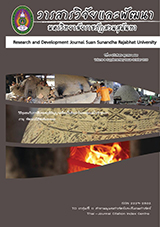ความเจ็บป่วยและการแสวงหาการดูแลสุขภาพของแรงงานข้ามชาติกัมพูชา ที่ตลาดการค้าชายแดนช่องจอมจังหวัดสุรินทร์
DOI:
https://doi.org/10.53848/irdssru.v8i2.214467คำสำคัญ:
แรงงานข้ามชาติกัมพูชา, เครือข่ายความปลอดภัยทางสังคม, การแสวงหาการดูแลสุขภาพ, ความเจ็บป่วย, ตลาดการค้าชายแดนช่องจอมบทคัดย่อ
การศึกษาครั้งนี้มีวัตถุประสงค์เพื่อศึกษาลักษณะความเจ็บป่วยและการแสวงหาการดูแลสุขภาพของแรงงานข้ามชาติกัมพูชาในตลาดการค้าชายแดนช่องจอมจังหวัดสุรินทร์ และหาความสัมพันธ์ระหว่างปัจจัยทางสังคมของแรงงานข้ามชาติกัมพูชากับสถานะสุขภาพและการแสวงหาการดูแลสุขภาพ โดยเครื่องมือที่ใช้ในการเก็บข้อมูล คือ แบบสอบถาม และวิเคราะห์ข้อมูลด้วยการกระจายความถี่แบบร้อยละ และหาความสัมพันธ์ด้วยการทดสอบ Chi-square กลุ่มตัวอย่างเป็นแรงงานข้ามชาติกัมพูชาที่ข้ามมาทางานในบริเวณพื้นที่ตลาดการค้าชายแดนช่องจอมจังหวัดสุรินทร์จานวนทั้งสิ้น 350 คน ผลการศึกษาพบว่าร้อยละ 63.7 ของกลุ่มตัวอย่างมีการรายงานอาการความเจ็บป่วยในช่วง 1 เดือนที่ผ่านมา ส่วนใหญ่เจ็บป่วยด้วยอาการหวัด/ไอ/คัดจมูก/น้ามูกไหล/เจ็บคอโดยพบว่าแรงงานที่เป็น เพศหญิง ผู้ที่มีอายุมากกว่า 40 ปีผู้ที่มีโรคประจาตัวและผู้ที่มีสถานะการทางานเป็นลูกจ้างมีโอกาสเจ็บป่วยมากกว่ากลุ่มอื่น ๆ ซึ่งเมื่อเจ็บป่วยแรงงานข้ามชาติชาวกัมพูชาร้อยละ 54.3 เลือกที่จะเยียวยารักษาอาการเจ็บป่วยด้วยตนเอง ส่วนที่เหลือมีการแสวงหาการดูแลสุขภาพที่สถานบริการสุขภาพประเภทต่าง ๆ โดยร้อยละ 74 ของผู้ที่ใช้บริการสุขภาพนั้นใช้บริการสุขภาพในประเทศไทยโดยส่วนใหญ่ไปใช้บริการสุขภาพที่โรงพยาบาลของรัฐ ตามด้วยโรงพยาบาลเอกชน คลินิกเอกชน และสถานีอนามัย ตามลาดับ ส่วนที่เหลือร้อยละ 26 กลับไปใช้บริการสุขภาพที่กัมพูชา ทั้งนี้ จากการศึกษาพบว่า ผู้ที่เจ็บป่วยปานกลางถึงรุนแรง เป็นเจ้าของกิจการ ทางานในตลาดการค้าช่องจอมมาเป็นเวลานาน มีรายได้สูง มีบัตรอนุญาตทางาน ใช้พาสปอร์ตเป็นเอกสารในการข้ามแดน สามารถพูดภาษาไทยได้ และมีเครือข่ายความปลอดภัยทางสังคมที่ไม่เป็นทางการจะไปใช้บริการสุขภาพที่สถานบริการสุขภาพในประเทศไทยมากกว่ากลับไปใช้บริการสุขภาพที่กัมพูชา และยังพบว่ามีกลุ่มประชากรที่ไม่สามารถเข้าถึงบริการสุขภาพ โดยเฉพาะอย่างยิ่งในแรงงานที่เป็นลูกจ้างหรือรับจ้างทั่วไป ดังนั้น หน่วยงานที่เกี่ยวข้องกับ การจัดการพื้นที่ตลาดการค้าชายแดนช่องจอมและการดูแลแรงงานข้ามชาติควรส่งเสริมให้มีเครือข่ายความปลอดภัยทางสังคม โดยอาจจัดให้มีกลุ่มอาสาสมัครชาวกัมพูชาที่คอยให้คาแนะนาเมื่อแรงงานต้องการความช่วยเหลือ ให้ความรู้หรือข้อมูลเกี่ยวกับสุขภาพ หรือเป็นล่ามแปลภาษาให้แก่ผู้ที่ต้องการใช้บริการสุขภาพ เป็นต้น
เอกสารอ้างอิง
Swardt, C. (2004). Perceptions of
informal safety nets: A case study
from a South African informal
settlement. Development
Southern Africa, 21(3), 443-460.
doi:10.1080/0376835042000265432.
Banyat Sali. (2011). Informal
transnational workers:
Development of transnational
workers and management system
transnational workers in the
border area of Surin: The
Thailand Research Fund (TRF)
Department of National Policy and
international relations (Department
1).
Biswas, D., Kristiansen, M., Krasnik, A., &
Norredam, M. (2011). Access to
healthcare and alternative healthseeking
strategies among
undocumented migrants in
Denmark. BMC Public Health,
11(1), 560.
Devereux, S. (1999). 'Making less last
longer': informal safety nets in
Malawi.
Dias, S., Severo, M., & Barros, H. (2008).
Determinants of health care
utilization by immigrants in
Portugal. BMC Health Services
Research, 8(1), 207.
Eng, P. M., Rimm, E. B., Fitzmaurice, G., &
Kawachi, I. (2002). Social ties and
change in social ties in relation to
subsequent total and causespecific
mortality and coronary
heart disease incidence in men.
American journal of
epidemiology, 155(8), 700-709.
Guendelman, S. (1991). Health Care Users
Residing on the Mexican Border:
What Factors Determine Choice of
the U.S. or Mexican Health System?
Medical Care, 29(5), 419-429.
Heemskerk, M., Norton, A., & de Dehn, L.
(2004). Does Public Welfare Crowd
Out Informal Safety Nets?
Ethnographic Evidence from Rural
Latin America. World
Development, 32(6), 941-955. doi:
http://dx.doi.org/10.1016/j.worldde
v.2003.11.009.
Hendrikson, H. (2010). Migrant Social
Networks and Health Care:
Exploring the Relationship between
Women's Social Networks and
Migrant Health Care Access in the
United States. International
Journal of Migration, Health and
Social Care, 6(1), 3-14. doi:
doi:10.5042/ijmhsc.2010.0445.
Keller, A., & Baune, B. (2005). Impact of
social factors on health status and
help seeking behavior among
migrants and Germans. Journal of
Public Health, 13(1), 22-29. doi:
10.1007/s10389-004-0082-x.
Kushel, M. B., Vittinghoff, E., & Haas, J. S.
(2001). Factors associated with the
health care utilization of homeless
persons. Jama, 285(2), 200-206.
doi: 10.1001/jama.285.2.200.
Leclere, F. B., Jensen, L., & Biddlecom, A. E.
(1994). Health Care Utilization, Family
Context, and Adaptation Among
Immigrants to the United States.
Journal of Health and Social
Behavior, 35(4), 370-384. doi:
10.2307/2137215.
Leduc, N., & Proulx, M. (2004). Patterns of
Health Services Utilization by Recent
Immigrants. Journal of Immigrant
Health, 6(1), 15-27. doi:
10.1023/B:JOIH.0000014639.49245.c.
McDonald, C. L., Schiller, C. G., & Ueda, K.
(1999). Income distribution, informal
safety nets, and social expenditures
in Uganda.
Mikkonen, J., & Raphael, D. (2010). Social
determinants of health: The
Canadian facts: York University, School
of Health Policy and Management.
Nopparat Wongwitthayaphanit. (2011). The
development of Thailand border
market: Institute of studying public
policy Chiang Mai University.
Orathai Srithongtham. (2013). Full research
reports project the impact of Laos,
Cambodia and Myanmar
transnational workers, the workload
of health services in hospitals along
the border with Thailand: The office
of Disease Prevention and Control
Region 7 Ubon Ratchathani Department
of Disease Control Ministry of Public
Health.
Peng, Y., Chang, W., Zhou, H., Hu, H., &
Liang, W. (2010). Factors associated
with health-seeking behavior
among migrant workers in Beijing,
China. BMC Health Services
Research, 10(1), 69.
Sanz, B., Regidor, E., Galindo, S., Pascual,
C., Lostao, L., Díaz, J., & Sánchez, E.
(2011). Pattern of health services
use by immigrants from different
regions of the world residing in
Spain. International Journal of
Public Health, 56(5), 567-576. doi:
10.1007/s00038-011-0237-9.
Shaikh, B. T., & Hatcher, J. (2005). Health
seeking behaviour and health
service utilization in Pakistan:
challenging the policy makers.
Journal of Public Health, 27(1),
49-54.
doi:10.1093/pubmed/fdh207.
Supoj Dendoung. (2009). Filling the gaps
in health during our lives
Achieving equity of health by
social determinant of health:
Thai Health Promotion Foundation.
Wallace, S. P., Mendez-Luck, C., &
Castañeda, X. (2009). Heading
South: Why Mexican Immigrants in
California Seek Health Services in
Mexico. Medical care, 47(6), 662-
669. doi:
10.1097/MLR.0b013e318190cc95.
Yanagisawa, S., Mey, V., & Wakai, S. (2004).
Comparison of health-seeking
behaviour between poor and
better-off people after health
sector reform in Cambodia. Public
Health, 118(1), 21-30. doi:
http://dx.doi.org/10.1016/S0033-
3506(03)00140-9.
Zimmerman, C., Kiss, L., & Hossain, M.
(2011). Migration and Health: A
Framework for 21st Century Policy-
Making. PLoS Med, 8(5), e1001034.
doi: 10.1371/journal.pmed.100103.
ดาวน์โหลด
เผยแพร่แล้ว
รูปแบบการอ้างอิง
ฉบับ
ประเภทบทความ
สัญญาอนุญาต
บทความที่ได้รับการตีพิมพ์เป็นลิขสิทธิ์ของ สถาบันวิจัยและพัฒนา มหาวิทยาลัยราชภัฎสวนสุนันทา
ข้อความที่ปรากฏในบทความแต่ละเรื่องในวารสารวิชาการเล่มนี้เป็นความคิดเห็นส่วนตัวของผู้เขียนแต่ละท่านไม่เกี่ยวข้องกับมหาวิทยาลัยราชภัฎสวนสุนันทา และคณาจารย์ท่านอื่นๆในมหาวิทยาลัยฯ แต่อย่างใด ความรับผิดชอบองค์ประกอบทั้งหมดของบทความแต่ละเรื่องเป็นของผู้เขียนแต่ละท่าน หากมีความผิดพลาดใดๆ ผู้เขียนแต่ละท่านจะรับผิดชอบบทความของตนเองแต่ผู้เดียว





